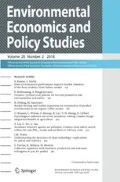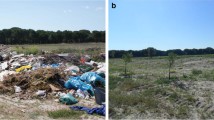Abstract
Important issues in the cleanups of illegal dumping sites of hazardous waste are cost, time, and safety. Two types of response actions, removal actions (off-site cleanups), and remedial actions (on-site cleanups), are likely to depend on these factors. However, the empirical evidence on this is lacking. Consequently, this study examines the determinants of removal decisions about dumped waste and contaminated soil from the site. Moreover, it examines the determinants of costs and periods to cleanup illegal dumping sites. This study indicates that removal actions tend not to be selected as the amount of dumped waste increases in case of pooled data. Removal actions tend to be selected when toxic materials are included in the sites in case of full removal and pooled data. Partial removals tend to be selected in higher income municipalities than in lower income ones, though this result is not an excellent fit to the model. Furthermore, this study shows that full and partial removal raises cleanup costs by approximately 236 and 180 %, respectively. However, the cleanup period remains unchanged regardless of whether removal or remedial actions are taken. On the other hand, inclusion of toxic waste prolongs the disposal period by approximately 69 %.

Similar content being viewed by others
Notes
In Japan, industrial waste includes both hazardous and nonhazardous waste, particularly, ash, sludge, waste oil, waste acid, waste alkali, waste plastics, and others, identified by a cabinet order among all the wastes left as a result of business activity. The total amount of industrial waste generated has been almost constant at approximately 400 million ton in Japan over the past decade. They are supposed to be properly disposed of. In contrast, the amount of illegal dumping has considerably decreased from 750 thousand ton in 2003 to 30 thousand ton in 2013.
The Japanese yen is converted into US dollars assuming an exchange rate of approximately 100 yen to 0.94 dollars (the average rate in 2014).
Panel data analysis would enhance the robustness of the study. However, it is difficult to collect panel data for all the variables used in the study because I cannot get yearly data for some variables (e.g., costs, disposal amount). Moreover, even if I could obtain the yearly data, some variables are constant over the period (e.g., cleanup options, toxic) while some variables fluctuate yearly (e.g., costs, disposal amount, income).
50 of all 76 sites (approximately 66 %) that occurred after June 17, 1998 and supported by Industrial Waste Site Restoration Fund were sites contaminated by sulfate pitch, which is a mixture of waste sulfate and waste hydrocarbon oil generated during the treatment process using concentrated sulfuric acid, aiming to remove the oil marker Coumarin contained in heavy oil and kerosene when illegal light oil is manufactured (MOE website). These incidents are excluded in this study due to their special characteristics. Consequently, the sample size becomes small, and this makes further detailed analysis difficult. However, I regarded well-balanced samples as more important. On other hand, the 17 sites occurred prior to June 17, 1998 and were supported by the Industrial Waste Site Restoration Fund and/or the Special Measures Acts correspond to all the sites. Here, this study considers the same sites as one site even if they are separated due to the contents of the cleanup actions on the original list.
Population density might be able to be an explanatory variable because prior cleanup may be required in urban areas due to higher external costs. I attempted to include population density as a representative variable of urbanization. However, a correlation coefficient between population density and average income was high (0.85). Consequently, I did not include population density as an explanatory variable.
However, the correlation between total removal and partial removal is somewhat high (−0.65). This is because if one option is selected, the other option is not selected. It does not matter much because the variance inflation factor (VIF) indicates that the correlations between these variables are negligible.
Because the sample size is small, the significant level might be more liberal, as noted by Wooldridge (2013).
Tail thickness is slightly different between probit and logit models. However, this is less important here because the marginal effects are computed at the average level. Here, I stress that the marginal effects by both models are similar.
For example, during the incident along the prefectural boundary between Aomori and Iwate, some dumped wastes were transported to cement factories, and which were utilized as a resource in cement production.
References
Alberini A, Longo A, Tonin S, Trombetta F, Turvani M (2005) The role of liability, regulation and economic incentives in brownfield remediation and redevelopment: evidence from surveys of developers. Reg Sci Urban Econ 35:327–351
Barth ME, McNichols MF (1994) Estimation and market valuation of environmental liabilities relating to superfund sites. J Account Res 32(Supplement):177–209
Forslund J, Johansson P, Samakovlis E, Vredin Johansson M (2009) Can we buy time? Evaluation of government’s directed grant to remediation in Sweden. National Institute of Economic Research Working Paper, 107
Fujikura M (2011) Japan’s efforts against the illegal dumping of industrial waste. Environ Policy Govern 21:325–337
Greenstone M, Gallagher J (2008) Does hazardous waste matter? Evidence from the housing market and the superfund program. Quart J Econ pp 951–1003
Gupta S, Houtven GV, Cropper ML (1995) Do benefits and costs matter in environmental regulation? An analysis of EPA decisions under superfund. In: Revesz RL, Stewart RB (eds) Analyzing superfund: economics, science, and law, Ch. 4, Resources for the Future
Gupta S, Houtven GV, Cropper ML (1996) Paying for permanence: an economic analysis of EPA’s cleanup decisions at superfund sites. RAND J Econ 27(3):563–582
McCluskey JJ, Rausser GC (2003) Stigmatized asset value: is it temporary or long-term? Rev Econ Stat 85(2):276–285
McFadden D (1977) Quantitative methods for analyzing travel behaviour of individuals: some recent developments, Cowles Foundation Discussion Papers, No. 474
Sigman H (2001) The pace of progress at superfund sites: policy goals and interest group influence. J Law Econ 44:315–344
Sigman H, Stafford S (2010) Management of hazardous waste and contaminated land, working papers, Department of Economics, Rutgers, the State University of New Jersey, No. 2010, 08
US Environmental Protection Agency (2009) Challenges in applying property value studies to assess the benefits of the superfund program. DC, Office of Superfund Remediation and Technology Innovation, Washington
White H (1980) A heteroscedasticity-consistent covariance matrix estimator and a direct test for heteroscedasticity. Econometrica 48(4):817–838
Wooldridge JM (2013) Introductory econometrics a modern approach, 5th edn. Cengage Learning, South-Western
Acknowledgments
I am grateful for the helpful comments provided by two anonymous referees.
Author information
Authors and Affiliations
Corresponding author
About this article
Cite this article
Sasao, T. Econometric analysis of cleanup of illegal dumping sites in Japan: removal or remedial actions?. Environ Econ Policy Stud 18, 485–497 (2016). https://doi.org/10.1007/s10018-015-0120-7
Received:
Accepted:
Published:
Issue Date:
DOI: https://doi.org/10.1007/s10018-015-0120-7




